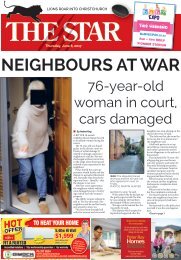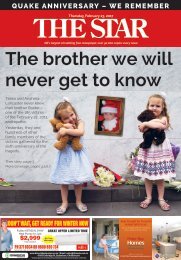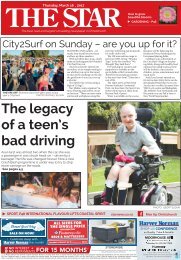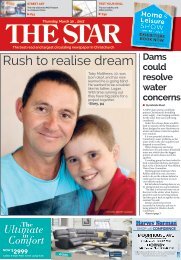Review of the Tsunami Evacuation 2017
You also want an ePaper? Increase the reach of your titles
YUMPU automatically turns print PDFs into web optimized ePapers that Google loves.
Bullet point 6. Consistent<br />
messaging across agencies.<br />
Bullet point 7. Residents want<br />
evacuation maps and information<br />
on tsunami.<br />
Bullet point 8. The community<br />
should be involved in developing<br />
plans.<br />
misinterpreted, can delay life-safety actions, and are not best practice for public alerting. Within<br />
<strong>the</strong> Standard it is explicitly stated that tsunami warning sirens:<br />
• Are inappropriate (and may increase <strong>the</strong> risk to <strong>the</strong> public) when used for local source<br />
tsunami),<br />
• Are only suitable for use for regional and distant source tsunami when accompanied by<br />
targeted and continuous public education<br />
• Are not to replace <strong>of</strong>ficial advice that natural warnings for local source tsunami are <strong>the</strong><br />
best warning for <strong>the</strong> public<br />
• Where <strong>the</strong>y are signal only (no voice capability) <strong>the</strong>y should always mean seek fur<strong>the</strong>r<br />
information and not indicate evacuation, all –clear, or any o<strong>the</strong>r meaning<br />
• Should be only one <strong>of</strong> a range <strong>of</strong> warning methods used by CDEM Groups to alert <strong>the</strong><br />
public<br />
Public education for <strong>the</strong> use <strong>of</strong> tsunami sirens should include information on how and when<br />
tsunami sirens will be used and have strong links to community response planning (including<br />
evacuation drills).<br />
Response planning for tsunami should include hazard and evacuation zone mapping, including<br />
sharing <strong>of</strong> <strong>the</strong>se zones with <strong>the</strong> public, preparing operating procedures for <strong>the</strong> use <strong>of</strong> sirens and<br />
understanding <strong>the</strong> limitations <strong>of</strong> sirens.<br />
MCDEM is concerned that <strong>the</strong> draft <strong>Review</strong> <strong>of</strong> <strong>the</strong> <strong>Tsunami</strong> <strong>Evacuation</strong> report states community<br />
members in at-risk locations will not take action to evacuate (ignoring all o<strong>the</strong>r <strong>of</strong>ficial warnings<br />
e.g. radio broadcasts and social media posts from <strong>of</strong>ficial agencies) unless <strong>the</strong>y hear a siren.<br />
MCDEM expects Christchurch CDEM to adhere to <strong>the</strong> <strong>Tsunami</strong> Sirens Technical Standard and work<br />
with communities to address this concern.<br />
Bullet points 5-8 cover public education and response planning. These are part <strong>of</strong> a wider process<br />
<strong>of</strong> planning for tsunami and are linked with <strong>the</strong> types <strong>of</strong> warnings systems used for tsunami,<br />
including understanding <strong>of</strong> natural warnings. Comprehensive guidance on engaging with <strong>the</strong><br />
public, mapping evacuation zones, developing local tsunami evacuation plans, working with<br />
communities and developing clear maps and public education materials are provided in <strong>the</strong><br />
documents referred to above. (See Figure 2).<br />
63















